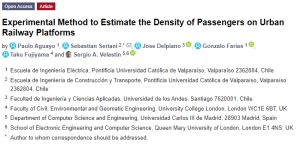Paulo Aguayo, Sebastian Seriani, Jose Delpiano, Gonzalo Farias, Taku Fujiyama, Sergio A. Velastin
The platform–train interface (PTI) is considered a complex space where most interactions occur between passengers boarding and alighting. These interactions are critical under crowded conditions, affecting the experience of traveling and therefore the quality of life. The problem is that urban railway operators do not know what the density at the PTI is in real time, and therefore it is not possible to obtain a measure of the personal space of passengers boarding and alighting the train. To address this problem, a new method is developed to estimate the density of passengers on urban railway platforms using laboratory experiments. In those experiments, the use of computer vision is attractive, through the training of neural networks and image processing. The experiments considered a mock-up of a train carriage and its adjacent platform. In the boarding process, the results showed that the density using Voronoi polygons reached up to a 300% difference compared to the average values of density using Fruin’s Level of Service. However, in the case of alighting, that difference reached about 142% due to the space available for wheelchair users who needed assistance. These results would help practitioners to know where passengers are located at the PTI and, therefore, which part of the platform is more congested, requiring the implementation of crowd management measures in real time. Further studies need to include other types of passengers and different situations in existing stations.
